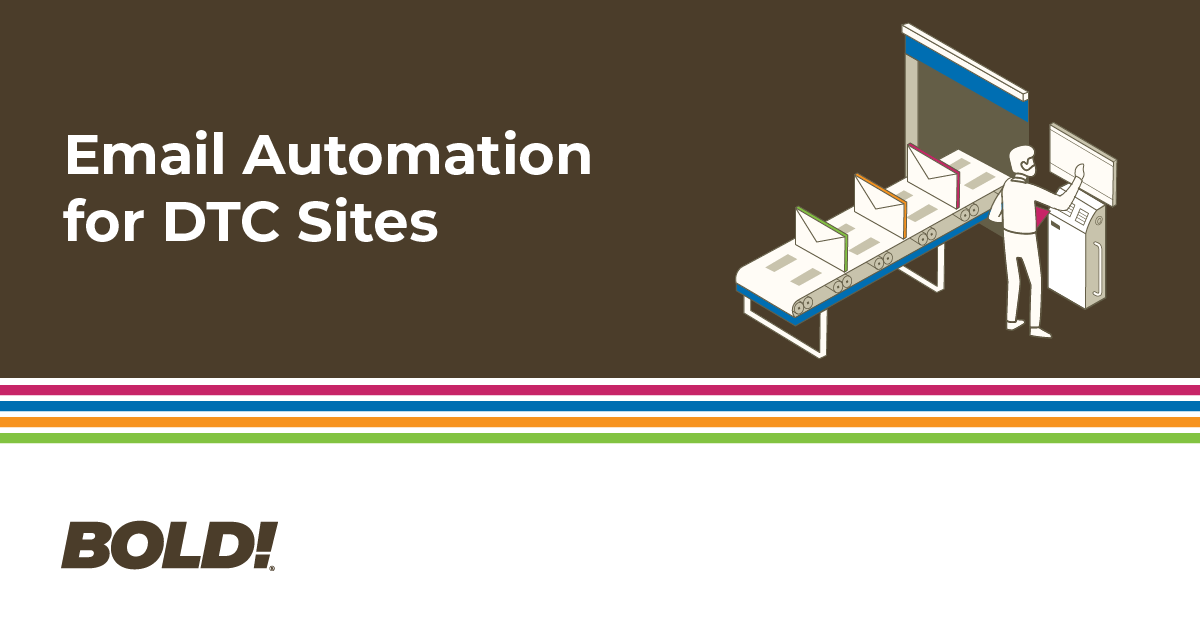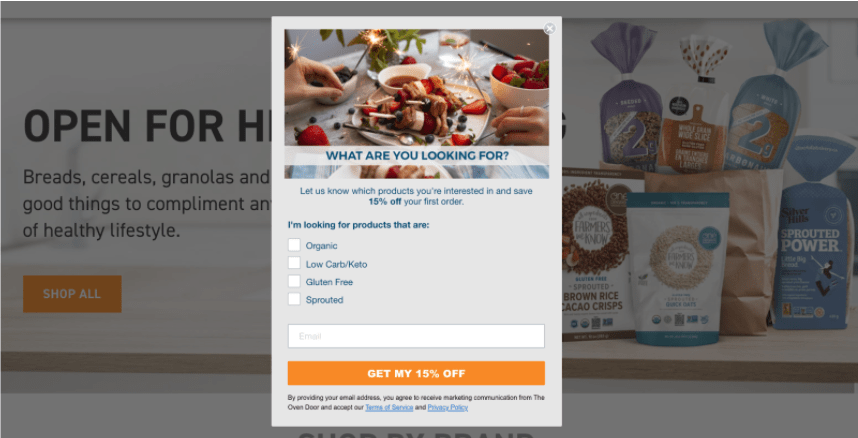Foundations of Email Automation on DTC Sites
December 2, 2021

Developing an email strategy can be a daunting task for any brand. There are many considerations- audiences, messaging strategy, timing, subject line, and, the list goes on and on.
One thing is certain, though, event-driven automated email workflows can be a game changer. In fact, these emails typically convert 2.5x better than bulk emails.
So what is email automation? Email automation is when you program an email or series of emails to be sent to a segmented audience based on a behavioral trigger or a period of time. These emails feel more personal because they’re sent based on an action a user has taken or data they have given you already such as their birthday or their favorite coffee drink.
If done correctly, email automation can deliver a “personal touch” without a whole lot of costly manual customization work. You can nurture relationships at scale!
To do this well, you’ll need to build a subscriber base, segment them, and then design custom flows. Here’s how!
Building Your Email Subscriber Base
First things first, you need an audience to send emails to. That requires compelling opt-in opportunities on your DTC site.
In addition to asking for email in your DTC opt-in opportunities, it’s also now best practice to ask for phone numbers for SMS campaigns. Most pop-up builders or email/SMS services now offer two-step opt-in options so brands can get both email and phone numbers at once.
All opt-in opportunities are definitely not created equal. While there are plenty of components that would elevate your opt-in to the next level, here are the key 4 that you’ll want to consider incorporating.
Key Components of Effective Opt-in Opportunities
1. Offer
First, you’ve got to have an offer for the shopper. Without one, there’s no reason for them to give you the information you’re asking for. A few effective examples are: discounts, free shipping, exclusive early access to a deal, or an insider club. If you want to get creative, you could create a quiz that the user can take, with the opt-in form at the end to fill out in order to get their results.
2. Effective Copy
You’ll want to use phrases that evoke emotion in the user. Something that piques their curiosity or communicates urgency is much more effective than “Sign-up for our emails.” It’s also important to utilize copy to gain the trust of the user. Use the headline to first grab attention, the body copy to convince them to opt-in, and the call-to-action to seal the deal.
3. Clear Call-To-Action
This is key to sealing the deal. Here, you’ll essentially want to tell your user exactly what action to take or what they will experience as a result of clicking. Anyone heard of “Don’t Make Me Think?” Instead of using the classic “Submit” or “Sign-Up” use phrases like “Get my 10% off” or “Become and Insider.” Remember, the user probably doesn’t want your email, they want the offer or value you’re giving to them.
4. Limit input fields
Get only the necessary information from your user. More fields equals more barriers to submission. In fact, simply asking for a user’s name makes them less likely to submit. We’d recommend asking for email, phone number, and maybe check a few boxes in order to segment your audience from the get go like the example below.

Email Audience Segmentation
Now that you have your growing email list, it’s time to think about segmentation. Audience segmentation is key to building a healthy email marketing list and creating engaging content for your subscribers. When building automated flows, it’s crucial to understand who your email is going to. Segmentation simply buckets your audiences into defined groups based on behavior, demographics, or interests. This allows you to develop highly personalized content to meet your audience at any point in the marketing funnel.
There are several ways to create meaningful segments either during or post opt-in process.
During the opt-in process
This is a key opportunity to gain meaningful insight on your audience’s interest. Are they interested in a specific product or brand? Or wanting more information about a product release? By giving your audience opportunities to select their interest, you can create highly specified segments and content targeted towards their individual interests. For a multi-product or multi-brand retailer, this can be a powerful tool in creating content flows.
Post opt-in
After your customer has opted in, there are plenty of opportunities to create segments based on their behavior. Here are three of our favorite segments:
1. The Repeat Purchasers
These are individuals who have made several purchases in the past and continue to purchase from your site. There is a huge opportunity to create automated flows for product refills, cross-selling, and basket building.
2. The Winbacks
These are people who have made a purchase in the past, still interact with content, but haven't purchased recently. Content for this segment could be centered around seasonal campaigns, discounts, new launches.
3. The Nearly Theres
The Nearly Theres continue to open your email and click on links, but have never made a purchase. It is important to create content that showcases reviews, product information, and heavy discounts in order to convert this segment.
Behavior-focused segments allow the marketer to understand how your marketing list is interacting with your content and further customize content based on their needs.
In the world of mass email marketing, audience segmentation generates personalization. This overall reduces the risk of unsubscribers and being placed in the spam folder.
Key eCommerce Email Automation Flows
Now that you’ve got your subscribers and segments, let’s get to what you’re really here for - the automation flows!
There are plenty of actions you can use to automate email workflows. It’s important to have designated workflows for actions taken before, during, and after the sale. We’ve broken each section down to the key workflows you’ll want to integrate into your email automation strategy.
Before the sale
-
Welcome
Welcome emails tend to get some of the highest open rates, largely because 74% of email subscribers have come to expect a welcome email following opt-in. Your welcome email flow will simply contain a welcome message and the offer that was promised in the opt-in form. You can also clarify expectations on the content you’ll send and how often the subscriber will be receiving emails from you.
A way to take your welcome sequence to the next level is to add additional emails to remind them to use their new deal. These can be after a few hours, days, or weeks, it’s best to A/B test to get a feel for how your subscribers respond.
-
Abandoned cart
Abandoned cart emails are a great way to re-engage your shopper and are a must for any DTC site. You can utilize exactly the items they were interested in as the creative elements in your email, providing a personalized and engaging experience.
For abandoned cart workflows, you definitely want to have more than just one email. It’s best to have a few spaced out. Once again, you’ll want to test this on your own subscribers, but a great starting point is to send one a few hours after abandonment, a day later, and then a few days after that.
You can also include an added deal such as a percentage off or free shipping to the second or third email. This could push your shopper over the edge to convert!
Have fun with these! You can get creative with the headline, preview text, and body copy. Write something your subscribers can’t resist!
During the sale
-
Order Confirmation
They made the purchase...but now what? Order confirmations are key to reassure your customer of a smooth transaction, thank your customer, and create excitement on the status of their order. These confirmations can be easily created and customized within your preferred shopping platform (for ex: Shopify) or partner integration.
-
Delivery Status
In the world of package thieves, it is important to update your customers on the status of their delivery. The two main delivery status emails include a notification of shipment and additional confirmation upon delivery. This not only ensures peace of mind, but further builds anticipation, and increases brand communication. These automations can also be activated within your shopping platform.
Post Purchase Retention
-
Review generation
Reviews are important for every eCommerce brand. Creating an automated flow to gather reviews after a purchase is an easy way to engage with your customers and receive feedback. We recommend sending your review request to a custom period based on when you think they’ll have fully experienced the product’s benefits. Consider offering a discount to encourage a repeat purchase.Finally, you may want to explore applications like YotPo to make review submission easier for your shoppers.
-
Replenishment Reminders
A great way to re-engage purchasers is to create an automated email for when its time to buy again. For example, if your product lasts the average consumer 30 days, sending an email after 25 days to remind your consumer to replenish and restock. This encourages repeat purchases and a long-term relationship.
Promotional sequences
You’ll want to identify the big events that can help you drive more sales and build sequences to drive shopper action in these periods. Leading into Black Friday, for example, you may consider a “coming soon” style email followed by a first set of deals and then a final set of “last chance” offers.
Not every promotional event applies to every shopper. Consider micro-events like a brand video launch or an influencer appearance to reach out to the shoppers who will find that content most interesting. More frequent, better-targeted events will likely deliver more than just a few big bang ones.
Bringing it all together
eMail automation doesn’t have to be difficult. While there are hundreds of ways to use email, if you implement the above approaches, you should be off to a great start. Need more assistance on executing your email marketing strategy? BOLD can help! BOLD’s eCommerce specialists, including our in-house creative team, can help manage your email marketing and eCommerce presence. We’d love to talk - Book your free expert consultation here!
